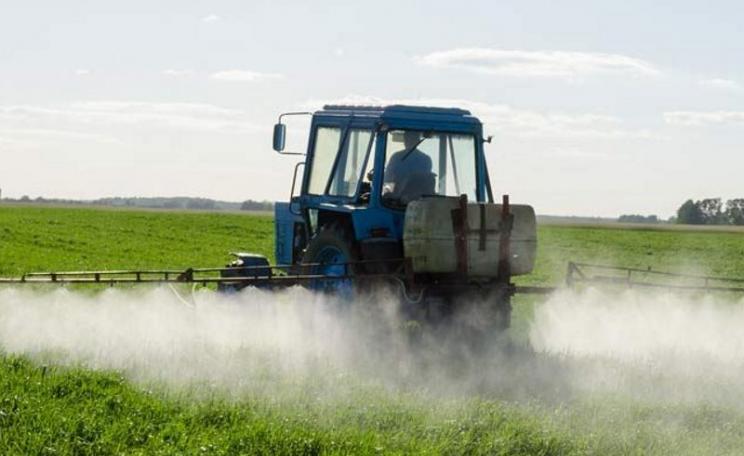Monsanto knew that scrutiny of the data in the studies could threaten its commercial ambitions, and so it asked for the research documents to be withheld and treated as 'trade secrets'. So there was no effective independent scrutiny.
According to evidence unearthed from the archives of the EPA in the United States, it has been established that Monsanto was fully aware of the potential of glyphosate to cause cancer in mammals as long ago as 1981.
Recently the WHO's International Agency for Research on Cancer (IARC) issued a statement in which glyphosate (the main component of Roundup herbicide) was classified as "probably carcinogenic" to humans and as "sufficiently demonstrated" for genotoxicity in animals.
This announcement of a change to toxicity class 2A was given vast coverage in the global media, causing Monsanto to move immediately into damage limitation mode. The corporation demanded the retraction of the report, before it was even published!
Predictably, there was more fury from the industry-led Glyphosate Task Force. This Task Force also sponsored a 'rebuttal' review article from a team of writers with strong links with the biotechnology industry.
But because of the clear bias demonstrated in this paper (which suggests that glyphosate has no carcinogenic potential in humans) it is best ignored until it has been carefully scrutinized by independent researchers.
EPA and Monsanto conspired to keep the evidence secret
With Monsanto continuing to protest that glyphosate and Roundup are effectively harmless if used according to instructions, in spite of accumulating evidence to the contrary, we undertook a search through Environmental Protection Agency (EPA) records with a view to finding out what was known about glyphosate at the time of its initial registration.
This followed up earlier investigations by Sustainable Pulse which highlighted a sudden change in the EPA view on toxicity in 1991. What was discovered was very revealing. There were many animal experiments (using rats, mice and dogs) designed to test the acute and chronic toxicity of glyphosate in the period 1978-1986, conducted by laboratories such as Bio/Dynamics Inc for Monsanto and submitted for EPA consideration.
Two of these reports relate to a three-generation reproduction study in rats (here and here). Another is referred to in 'Safety Evaluation and Risk Assessment of the Herbicide Roundup and Its Active Ingredient, Glyphosate, for Humans' as "Lankas, G. R. (1981). A Lifetime Feeding Study of Glyphosate (Roundup Technical) in Rats. Unpublished report, Bio/Dynamics, Inc., East Millstone, NJ."
Monsanto knew that scrutiny of the data in the studies could threaten its commercial ambitions, and so it asked for the research documents to be withheld and treated as 'trade secrets'. So there was no effective independent scrutiny.
No surprise that the article concludes that "under present and expected conditions of new use, there is no potential for Roundup herbicide to pose a health risk to humans." But the Lifetime Feeding Study remains unpublished and treated as a Trade Secret, unavailable for independent scrutiny.
That in itself is suggestive that the studies contain data which Monsanto still does not wish to be examined by experts in the toxicology field. It is also deeply worrying that EPA acceded to the routine Monsanto requests for secrecy on the flimsiest of pretexts.
However, archived and accessible EPA Memos from the early 1980's do give some indications as to what the rat studies contain. Although the studies predate the adoption of international test guidelines and GLP standards they suggest that there was significant damage to the kidneys of the rats in the three-generational study: the incidence of tubular dilation in the kidney was higher in every treated group of rats when compared to controls.
Tubular dilation and nephrosis was also accompanied by interstitial fibrosis in all test groups and in some of the lumens the researchers found amorphous material and cellular debris. Less than a third of the control rats showed signs of tubular dilation.
In the rat study results, the changes in the bladder mucosa are significant because metabolites, concentrated by the kidneys, have led to hyperplasia that could be considered as a very early and necessary step in tumour initiation.
EPA was worried in 1981 that these indications were sinister, and at first declined to issue a NOEL (no observed adverse effect level), asking for further information and additional research. In its 1982 Addendum, Monsanto presented evidence that minimised the effects and confused the data - and on that basis EPA accepted that glyphosate was unlikely to be dangerous.
But Monsanto knew that scrutiny of the data in the studies would potentially threaten its commercial ambitions, and so it asked for the research documents concerned to be withheld and treated as 'trade secrets'. So there was no effective independent scrutiny. Monsanto and EPA connived in keeping these documents away from unbiased expert assessment, in spite of the evidence of harm.
EPA dismissed fears as 'a mystery'
It is clear that EPA was thinking about carcinogenic effects - it knew in 1981 that glyphosate caused tumorigenic growth and kidney disease but dismissed the finding as "a mystery" in order to set the NOEL for the chemical and bring it to market.
In the rat studies, the glyphosate doses fed to the test groups were 1/100 of those used in a later mouse study. It is unclear why these very small doses were decided upon by Monsanto and accepted by EPA, since there must be a suspicion that the studies were manipulated or designed to avoid signs of organ damage.
In its 1986 Memo, EPA remarked on the very low doses, and said that no dose tested was anywhere near the 'maximally tolerated dose'. Then the Oncogenicity Peer Review Committee said: "At doses close to an MTD, tumours might have been induced." A repeat rat study was asked for.
However, Bio/Dynamics (which conducted the research for Monsanto) used data from three unrelated studies, which they conducted in house, as historical controls to create 'experimental noise' and to diminish the importance of the results obtained by experiment.
In an unpublished 1983 mouse study conducted by Bio/Dynamics Inc for Monsanto (10), and submitted to the EPA, there was a slight increase in the incidence of renal tubular adenomas (benign tumours) in males at the highest dose tested. Malignant tumours were found in the higher dose group.
However, "it was the judgment of two reviewing pathologists that the renal tumors were not treatment-related". Other effects included centrilobular hypertrophy and necrosis of hepatocytes, chronic interstitial nephritis, and proximal tubule epithelial cell basophilia and hypertrophy in females.
The EPA committee determined there was a "weak oncogenic response" - so evidence was suggestive of early malignancy. The EPA Science Advisory Panel was asked for advice, and they said the data were equivocal and called for further studies in mice and rats.
Confusion by an excess of data
A further report was delivered in 1985. Part of the reason for this dithering was the prevalent but false EPA belief that all physiological effects had to be dose-related: namely, the higher the dose, the greater the effect.
Even though pre-cancerous conditions were imperfectly understood 35 years ago, and cortical adenomas in kidney were not thought dangerous at the time, the evidence from the Memos is that Monsanto, Bio/Dynamics Inc and the EPA Committees involved were fully aware, probably before 1981, of the carcinogenic potential of glyphosate when fed to mammals.
In the Memos there are references to many more "secret" animal experiments and data reviews, which simply served to confuse the regulators with additional conflicting data. Thus EPA publicly accepted the safety assurances of the Monsanto Chief of Product Safety, Robert W. Street, and the status of the product was confirmed for use in the field.
But behind the scenes, according to a later EPA memo (in 1991), its own experts knew before 1985 that glyphosate causes pancreatic, thyroid and kidney tumors. On the EPA website (last updated 31/10/2014) reference is made to five Monsanto studies of 1980 - 1985, and it is noteworthy that these studies have not been made public in the light of current knowledge about malignant tumours and pre-cancerous conditions.
Neither have they been revisited or reinterpreted by Monsanto and EPA, although one 1981 rat study and one 1983 mouse study are mentioned in the recent review by Greim et al (2015). Following the conclusion that glyphosate was "not classifiable as to human carcinogenicity" nothing in the EPA advice about this chemical has changed since 1990.
Given the recent assessment by the WHO Panel, and given the flood of scientific papers relating to health damage associated with glyphosate (here, here and here) the EPA attitude smacks of complacency and even incompetence.
They knew - and they knew they knew
"The evidence shows that by 1981 both Monsanto and the EPA were aware of malignant tumours and pre-cancerous conditions in the test animals which were fed small doses of glyphosate in the secret feeding experiments", says Dr Brian John of GM-Free Cymru.
"Although concerns were expressed at the time by EPA committees, these concerns were later suppressed under the weight of conflicting evidence brought forward by Monsanto, some of it involving the inappropriate use of historical control data of dubious quality. None of these studies is available for independent examination. That is a scandal in itself. There has been a protracted and cynical cover-up in this matter.
"Glyphosate is a 'probable human carcinogen', as now confirmed by the WHO Working Group, and no matter what protestations may now come from Monsanto and the EPA, they have been fully aware of its potential to cause cancer for at least 35 years.
"If they had acted in a precautionary fashion back then, instead of turning a blind eye to scientific malpractice, glyphosate would never have been licensed, and thousands of lives might have been saved."
We would expect to see an increase in human carcinogenesis
Retired Academic Pathologist Dr Stanley Ewen says: "Glyphosate has been implicated in human carcinogenesis by IARC and it is remarkable that, as early as 1981, glyphosate was noted to be associated with pre neoplastic changes in experimental mice. This finding was never revealed by the regulatory process and one might therefore expect to see human malignancy increasing on the record in the ensuing years.
"John Little (personal communication) has demonstrated an unexpected and alarming 56% upsurge in malignancy in England in those under 65 in the past 10 years. Presumably British urinary excretion of glyphosate is similar to the documented urine levels in Germany, and therefore everyone is at risk. The effect of glyphosate on endocrine tissue such as breast and prostate, or even placenta, is disruptive at least and an increased incidence of endocrine neoplasia is likely to be seen in National Statistics.
"The Glyphosate Task Force denies the involvement of glyphosate in human malignancy despite their knowledge of many reports of lymphomas and pituitary adenomas in experimental animals dosed with glyphosate.
"On the other hand, Prof. Don Huber at a recent meeting in the Palace of Westminster, has warned of severe consequences if rampant glyphosate consumption is not reined in. I feel sure that the suppression of the experimental results of 1981 has enhanced the global risk of malignancy."
No medication without informed consent
Toxico-pathologist Professor Vyvyan Howard emphasised that glyphosate is, in fact, a patented antibiotic as well as being highly pharmacologically active and thus should be considered as a pharmaceutical product:
"The drive towards transparency in the testing of pharmaceuticals is gathering pace with legislation in the EU, USA and Canada being developed. All trials for licensed drugs will likely have to become available in the public domain.
"In my opinion the case with agrochemicals should be no different. At least with pharmaceuticals exposure is voluntary and under informed consent. There are several biomonitoring studies which demonstrate that there is widespread exposure of human populations to glyphosate, presumably without informed consent.
"Given the clear level of mistrust over the licensing of this herbicide and the emerging epidemiological evidence of its negative effects there can, in my opinion, be no case whatsoever for keeping the toxicological studies, used to justify licencing, a secret. They should be put in the public domain."
Nations must stand together against Monsanto
Research scientist Dr Anthony Samsel says: "Monsanto's Trade Secret studies of glyphosate show significant incidence of cell tumors of the testes and tumorigenic growth in multiple organs and tissues. They also show significant interstitial fibrosis of the kidney including effects in particular to the Pituitary gland, mammary glands, liver, and skin.
Glyphosate has significant effects to the lungs indicative of chronic respiratory disease. Glyphosate has an inverse dose response relationship, and it appears that its effects are highly pH dependent. Both Monsanto and the EPA knew of the deleterious effects of this chemical in 1980 at the conclusion of their multiple long-term assessments, but the EPA hid the results of their findings as 'trade secrets'.
"Monsanto has been lying and covering up the truth about glyphosate's harmful effects on public health and the environment for decades. The increases in multiple chronic diseases, seen since its introduction into the food supply, continue to rise in step with its use. Monsanto's Roundup glyphosate based herbicides have a ubiquitous presence as residues in the food supply directly associated with its crop use.
"Nations must stand together against Monsanto and other chemical companies who continue to destroy the biosphere. We are all part of that biosphere and we are all connected. What affects one affects us all."
This article was originally published as a special report by GM-free Cymru. Refer to the original for additional notes, etc.




